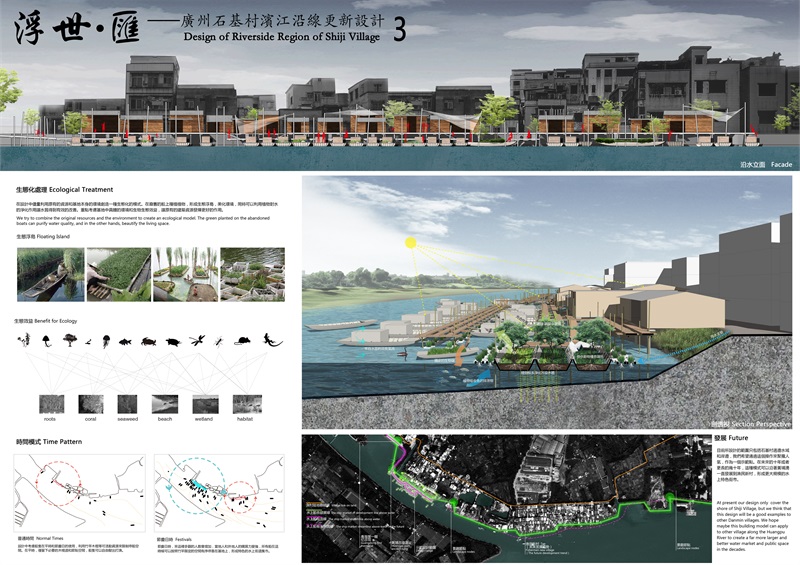


1、作品项目资料(Project data):
项目名称: 中文(Chinese) 浮世·汇—广州石基村滨江沿线更新设计
英文(English) Design of Riverside Region of Shiji Village
作品所选地点(Location):广东省广州市
总用地面积(Land Area):28000㎡
总建筑面积(Gross Floor Area):13500㎡
容积率(Floor Area Ratio):0.48
2、项目简介(中文)
建筑资源多种多样,有混凝土的朴实,有玻璃的靓丽,然而再拥有华丽外表的他们也终将有壹天会衰老而不能爲我们所用。当下环境生态持续恶化,如何利用可持续发展的观念进行建造和设计,是我们首当其冲要考虑的问题。本次竞赛题目爲“建筑资源再利用”,设计者从身边的环境入手,选取广东省广州市石基村爲设计节点,以疍民文化和连家船爲着眼点,以期在建筑资源的再利用和更新下发挥渔村新的生命力。
疍民,也称爲连家船民,是中国古代东南沿海的少数名族,其中尤以广东省的疍民文化历史悠久。疍人水居,以船爲室,传统上他们重视漂泊于水上,以船爲家,以船爲生,连家船是疍民主要的工作空间和生活空间,每艘船住着壹家人或壹个小家庭。他们的生産劳动在船头的甲板,船舱是家庭卧室和仓库,有时疍民还在船尾饲养家禽。江边的棚屋多爲渔民在休渔时期搭建的临时居所,连家船通过栈道与江边的棚屋相连。随着时间变迁和受陆地文化的影响,疍民上岸后另选择业,连家船逐渐被荒弃,疍家文化日渐消落,目前广州的疍民已所剩无几,其破旧的船坞与棚屋也面临着被遗弃的命运,这些具有历史文化记忆的建筑元素将随被吞噬乃至消亡。
设计从身边的环境出发,基地选址与广州珠江边的石基村。石基村为疍民上岸后所建设的村落,有着与广州城中村相似的特征。村中的许多居民仍保留有船只,但由于渔业不景气,几乎很少使用。江边的棚屋曾是他们上岸时的临时居所,现在大多空置,有些则用作储物用房。石基村两侧为宾江公员,但宾江公共空间再石基村几处被打断。场地中现存的棚屋、竹竿、连家船,以及木板等建筑废弃材料将成为我们主要利用的建筑材料。同时,我们考虑通过置入新的産业与功能,实现对现状的资源进行更新与改造,让破旧的船坞在新的时代下散发新的生命力。例如在特定的节日、在休渔期,渔民可以齐聚新村码头将船首尾相拼构成集市;也可以利用破旧的船坞进行生态养殖与净化。目前所设计的范围只包括石基村外围水域和岸边,我们希望通过这个操作来聚拢人气,作爲壹个示范点。在未来的十年或者更长的几十年,这种模式可以沿着黄埔冲壹直发展到渔民新村,形成更大规模的水上特色街市。
在设计中我们尽量利用原有的资源和基地本身的环境创造壹种生态化的模式。在废旧的船上种植植物,形成生态浮岛,美化环境,同时可以利用植物对水的净化作用让水质得到有效的改善。重点考虑基地中具体的环境和生物生态效益,让原有的建筑资源发挥更好的作用。通过对连家船的再利用与新村空间的规划设计,在宏观尺度上解决渔民新村空间秩序混乱、生态环境恶劣、蛋民文化日益消逝等问题,在微观尺度上爲村民营造新的公共空间环境,以期改善渔民生活状态的同时带动当地渔民参与性,使城市居民和渔村居民在这边土地上共同创造记忆,爲渔村注入新的活力与人气,使疍家文化得以传承和发展。
2、项目简介(英文)
It is known to us that there are many kinds of building materials, such as concrete, glass, and etc. However, there will be one day that they would be so aged and cannot be used for us. The current problem of environment pollution is getting worse and worse, it is crucial for us to consider how to make a good design with sustainable development idea. The title of this competition is “Reuse of the building materials” according to the current problem and the environment, we choose Guangdong ShiJi village as our basic site. The design start with the “Danjia culture” and “Lianjiachuan”, we hope to give a new life to the village according to our transformation and reuse of the materials.
“Danmin”, also known as the Lianjiachuan, is the minority migrants located in the Chinese Ancient Southeast Coast. Danmin culture has a long history especially in Guangdong Province.In traditional, they live on the boat as well as make a living by the boat. It has more than 30 thousand people in 1927, from 1950, Chinese government has arranged Danmin to get ashore as well as built many fishing village along the coast in the Pearl River. Today, affected by the land culture, DanJia culture has lost a lot and there is only few Danmin living along the river, in the case of this situation, what could we do to these historic and cultural memory architecture elements?
Our design located in ShiJi village along the Pearl River shore, which built by the “Danmin”, an old, traditional population living in the boats for hundred years ago in china. Although the Danmin h**e been moved on the land to live, most of them still keep the boats. Due to the water pollution, the Danmin h**e stopped fishing to make their living and the boats are out of usage. They also built a lot of bamboo huts by the river to be a temporary residence, which now become a storage room.
We found that during the process of their migration, Danmin le**e a lot of waste along the shore such as huts, bamboo poles, house-boats and other construction waste. So we manage to make good use of these waste to build something to help these villagers. At the same time, we consider to lead a new way of production and function management to achieve the status of resource renewal and transformation, and give a new life for the abandoned boats and huts. For example, in a particular festival or in the period of fishing moratorium, fishermen could gather together to the ShiJi village to @@Create a floating market and we also could use the abandoned boats to h**e an ecological farming. At present our design only cover the shore of ShiJi Village, but we think that this design will be a good example for other Danmin villages. We hope maybe this building model can apply to other village along the Huangpu River to @@Create a larger and better water market and public space in the decades.
We try to combine the original resources and the environment to @@Create an ecological model. The green planted on the abandoned boats can purify water quality, and on the other hands, beautify the living space.According to the reuse of the “Lianjiachuan” and the design of the ShiJi Village, on a large scale maybe we could solve the disorder of the inner street space, the environment pollution and the lost of the Danjia culture and other problems; on a small scale we could @@Create a comfortable public space for the residents as well as to increase the villagers' s involvement to build the village. At the same time, we could make a common memory for the city dwellers and the villagers and inject new vitality and popularity for the Fishing village which is good for the sustainable development of the Danjia cultural.
大图链接:
32浮世·汇——广州石基村滨江沿线更新设计1.jpg
32浮世·汇——广州石基村滨江沿线更新设计2.jpg
32浮世·汇——广州石基村滨江沿线更新设计3.jpg